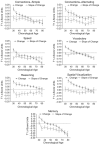Effects of age on time-dependent cognitive change
- PMID: 21467547
- PMCID: PMC3631712
- DOI: 10.1177/0956797611404900
Effects of age on time-dependent cognitive change
Abstract
Interpretation of cognitive change has been complicated because different influences on change are not easily distinguished. In this study, longitudinal cognitive change was decomposed into a component related to the length of the interval between test occasions (i.e., time-dependent change) and a component unrelated to the test-retest interval (i.e., time-independent change). Influences of age on the two hypothesized components were investigated in a sample of more than 1,500 adults for whom the intervals between test occasions ranged from less than 1 year to more than 8 years. Although overall change was negatively related to age for all seven composite cognitive variables, little or no effect of age was apparent for the time-dependent component of change. The results suggest that the relations between age and cognitive change over intervals of less than 8 years are largely influenced by factors operating at or near the initial test occasion.
Conflict of interest statement
Figures


References
-
- Baltes PB, Reese HW, Nesselroade JR. Life-span developmental psychology: Introduction to research methods. Monterey, CA: Brooks-Cole; 1977.
-
- Campbell DT, Stanley JC. Experimental and quasiexperimental designs for research. Chicago, IL: Rand McNally & Co.; 1963.
-
- Cohen G, Stanhope N, Conway MA. Age differences in the retention of knowledge by young and elderly students. British Journal of Developmental Psychology. 1992;10:153–164.
-
- Cohen J, Cohen P, West SG, Aiken LS. Applied multiple regression/correlation analysis for the behavioral sciences. 3rd. Mahwah, NJ: Erlbaum; 2003.
-
- Earles JL, Coon VE. Adult age differences in long-term memory for performed activities. Journal of Gerontology: Psychological Sciences. 1994;49:P32–P34. - PubMed
Publication types
MeSH terms
Grants and funding
LinkOut - more resources
Full Text Sources
Medical

